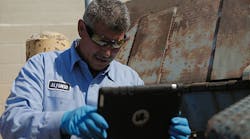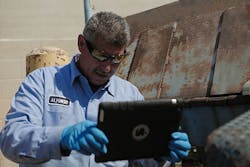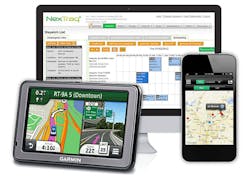CHICAGO — The laptop, the tablet computer and the smartphone have become tools as essential to the service technician as the power drill or tape measure. Mobile technology is now a part of almost every phase of a service operation, from scheduling and dispatch to inventory, customer service history, product service history, reference, billing, communication and more.
Nothing over the past 15 years has done more to increase the scope and efficiency of mobile service operations than advances in mobile technology, and the coming decade is going to make those gains look like small potatoes.
Mobile platforms are evolving, cloud-based apps and applications are becoming more sophisticated, and the inter-communication of devices — the Internet of Things — is going to deliver a wealth of information and functionalities that were undreamed of only a few years ago.
Internet of Things
Hari Subramanian is the co-founder and Chief Technology Officer for ServiceMax, a company that offers a suite of field service management solutions to its customers. As an entrepreneur and technologist, Subramanian has made the future his business, and today the future looks very exciting.
“[The Internet of Things] is probably going to be bigger than the Internet in terms of the impact it is going to have… It is going to impact all of mankind, in a very fundamental way, for decades to come. And service, I would say, is the ‘killer app’ for realizing the potential of IoT,” Subramanian said.
Essentially, the Internet of Things means that more and more devices will be able to monitor and regulate themselves, and will wirelessly connect to the Internet. End users or technicians in turn can monitor and regulate these devices from any mobile platform.
Examples include thermostats that know when the homeowner has left and automatically dial down the temperature; water heaters that send a signal when there’s a potential leak; or any number of intelligent building automation systems.
The endgame is selling not just a product, but a guaranteed outcome. Instead of selling a geothermal heat pump, the contractor/installer is selling energy. Instead of selling a radiant heating system, the hydronic engineer is selling comfort. And there is never a hitch in the user experience because the breakdown never happens — the device calls the technician for service before the breakdown even occurs.
In its most basic form, the Internet of Things allows for the collection and cataloging of meaningful product data. “We are rolling out a product called Product I.Q.,” said Subramanian, “a mobile app that allows our customers to gather, collect and catalog installed product information and provide visibility to that information to various entities within their organization.”
With up-to-the-moment information, technicians will know the specifics of a product’s service history; when it was installed, when most recently serviced, any problems that were discovered, etc. That detailed history, there in the palm of the tech’s hand, impacts all sorts of metrics: first time fixed rates, mean time to repair, time on site and so forth.
After cataloging, the second element of IoT is analytics; taking all the information gathered from these intelligent devices and extracting meaningful data from it.
Internet of Things discussed at Plumbing Industry Leadership Coalition meeting
Revenue from Internet of Things devices expected to reach $70 Billion in 2025
“Service contracts, warranties, they are all based on assumed behavior of the machines,” Subramanian said, “how they are going to function, how they are going to perform. Once there is visibility to actual mission information, organizations are going to be able to offer optimized contracts.”
Over time, that data is going to make it up the service chain right back to original equipment manufacturers, which will in turn affect the next generation of products.
The third element will be collaboration, and this is still a developing aspect of the Internet of Things. It means more than reading the notes of the last service tech to perform maintenance on a building system; more than being able to e-mail or Facetime with that tech. It is about the information exchanged whenever two technicians communicate.
“Who is harnessing that?” asked Subramanian. “There has to be an intelligent system that harvests that data and makes it available to the entire service platform, to other technicians, to other problems that are being solved at the same time. So it requires a lot more sophisticated collaboration/knowledge based experience that is unique to field service.”
Form follows function
First came the pager, then the cell phone, then the laptop with air card. Now we live in an age when new mobile platforms are being released at a dizzying rate. Popular now on the work site is the phablet — a compromise between the smartphone and the tablet that offers some of the advantages of both.
The advent of Google Glass and now the Apple Watch has the mobile tech industry buzzing about “wearables,” which would seem to be an ideal solution for the service industry. Technicians, after all, always seem to have their hands full.
Not so fast says Mark Huffman, who is senior director of Business Development for NexTraq, a fleet management and telematics company that today serves more than 110,000 subscribers.
“If you want to reduce things down to button size, that’s great,” said Huffman, “but that’s not typical of the service business.” Service techs typically need more data, and while screen resolutions have improved dramatically in the last 10 years, it is the size of the screen that’s still the final limiting “bandwidth.”
“It depends on the roles you play,” Huffman continued, “whether you’re a supervisor or an actual implementer or technician… a technician is going to bang things around. You can’t put a wearable down in that format because it’s going to get smashed, lost or not be readable.”
Where a wearable does make sense is for functions that only require the press of a button, such as accepting a job or clocking in at a jobsite. Other specific functions may require customized mobile platforms. For example, blueprints may be displayed on a kiosk at a jobsite that features a screen large enough, so they may be easily read. All of which means there is plenty of room at the table for any number of different platforms.
But Huffman feels that the impetus is going to be getting more people closer to the actual work being done. “Most of the small- to medium-sized businesses we deal with… they are out in the field amongst their workforce,” he said. “They’re not sitting behind their desks doing it from a command center.”
Living on the cloud
With more and more apps and applications based on the cloud — remote servers connected wirelessly to devices — more and more information is moving to the cloud. Who is accessing that information and what purposes they can put it to means that data security is now the price of entry for any mobile service provider.
“Data security is always at the top of the list,” said Casey Powers, VP of Marketing for Exaktime, a maker of mobile workforce management solutions. “The day of people having servers in their own facilities, is, for the most part, gone. The vast majority of people have moved to the cloud and have [those security functions] managed by a top-tier cloud provider.”
While security on the cloud is always going to be a concern — one that evolving industry standards are constantly addressing — the flip side to that is access. Anyone who is properly authenticated can access that data.
Which means, according to powers, that the dream of a thousand jobsite supervisors has finally come true, “You can be everywhere at once; from your office, from your truck, anywhere.”
Exaktime’s application has a new feature, SiteHub, which allows a supervisor to log into three different jobsites. “They can see who’s working, what they’re doing, the approximate labor costs, even get a weather report for that area,” Powers said. Workers can even take detailed field notes — complete with pictures and voice recordings — all of it logged, time stamped and stored on the cloud.
While the continued development of mobile technology is going to have a big impact in all walks of life, that impact will probably be felt most strongly in the area of field service. From the way things look, that impact is going to be an overwhelmingly positive one.
Read the full Q&A with Hari Subramanian, CTO of ServiceMax.





